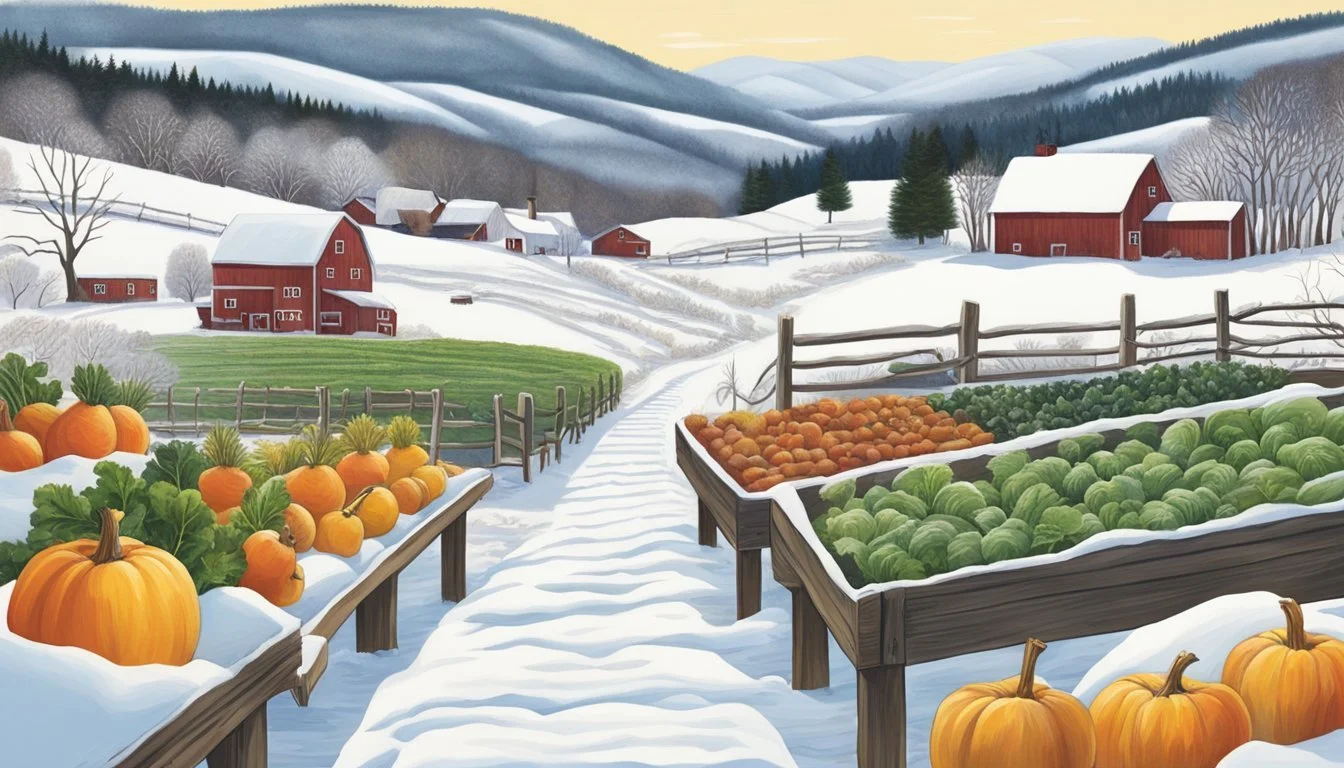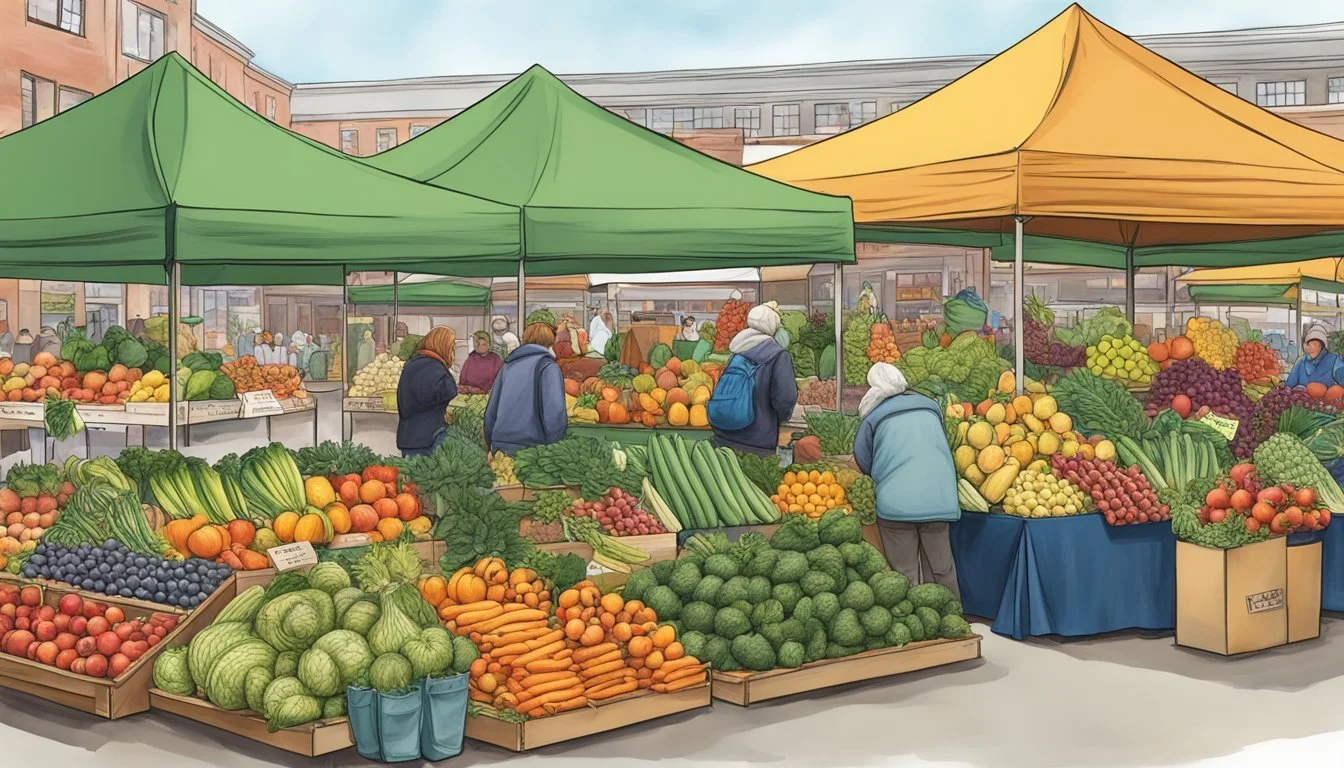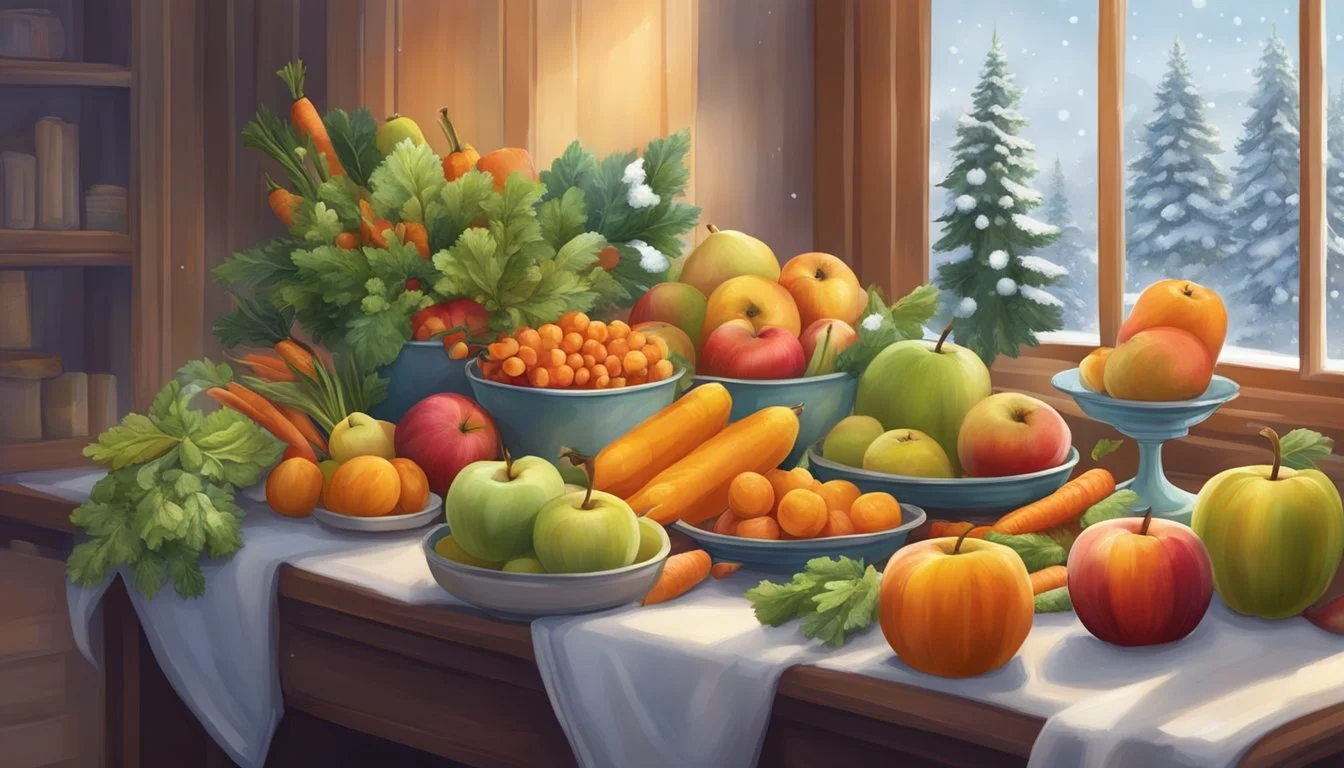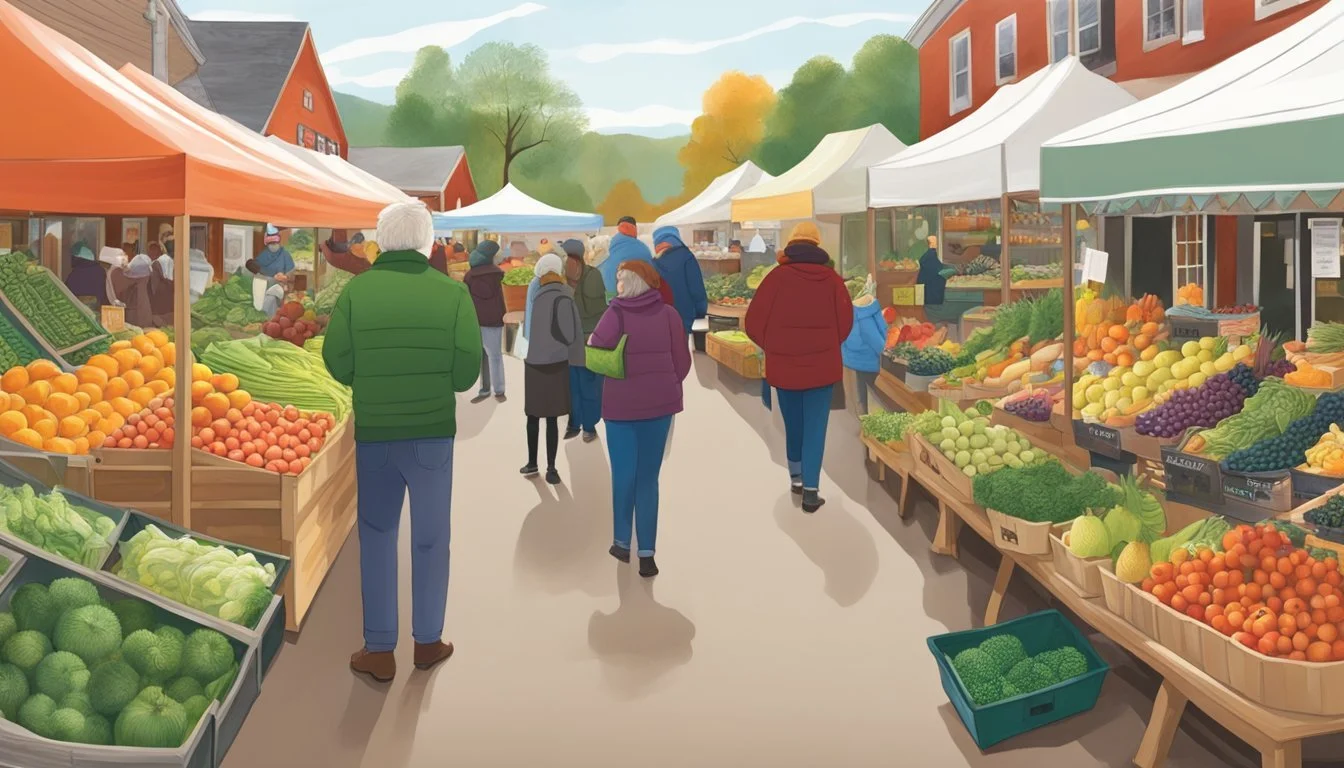Vermont Seasonal Fruit & Vegetables in December
Your Guide to Fresh Produce
This Article is Part of our Vermont Seasonal Fruit & Veg Calendar
In Vermont, December marks a time of transition as the landscape settles into winter's embrace. The month brings a shift in the availability of fresh produce, aligning with the seasonal rhythms that influence local agriculture. Root vegetables and hardy greens are prominent in this colder month, as they can withstand the chill of the New England climate. Winter's selection of fruits and vegetables, while more limited compared to the bountiful summer months, still offers wholesome and flavorful options for those seeking to eat seasonally and locally.
Seasonal fruits in December are few but cherished. The state's robust apple varieties, harvested in late autumn, continue to be available and offer a sweet, crisp counterpoint to the heartier vegetable fare. Cranberries, another fruit that enjoys a late harvest, can sometimes be found into early winter, providing tartness and a pop of color to Vermont's seasonal palette. These fruits, along with stored crops from earlier harvests, enable Vermonters to maintain a locally-sourced diet throughout the month.
For vegetables, Vermont in December is a showcase for the resilience of cold-weather crops. Root vegetables such as carrots (how long do carrots last?), parsnips, and beets (how long do beets last?) store well and maintain their earthy flavors, ready to be the backbone of many a comforting winter dish. In addition to roots, local farmers offer a variety of greens like kale, (What wine goes well with kale?) which can tolerate frost and even improve in sweetness after exposure to cold. The selection mirrors the state's commitment to sustainability and the community's support for local farms even as the year winds to a close.
Identifying Seasonal Produce
In December, Vermonters value seasonal eating, looking to root vegetables and hearty greens that thrive in the cooler growing season.
Importance of Seasonality
Seasonal produce not only offers peak flavor and nutrition but also aligns with the local agricultural calendar to support sustainability. Consumers can benefit from the heightened taste and maximized nutritional content that comes with consuming produce at its peak.
Vermont's Growing Season
Vermont's growing season shortens in December, prompting a shift in available produce. The emphasis is on root vegetables and cold-hardy greens. Here's a snapshot of what one can expect:
Root Vegetables: These staples store well and maintain quality in the cold. Look for:
Beets
Carrots
Potatoes
Radishes
Greens: Hardy varieties that live well into the month include:
Kale
Spinach
In-season fruits, though sparse, may include storage apples and pears. The knowledge of seasonal availability guides both consumers and chefs in making the best choice for fresh, local, and sustainable produce.
Winter Harvest
In December, Vermont's farms offer an abundance of hardy vegetables that withstand the cold climate. Root vegetables and winter greens are particularly resilient, providing fresh produce even during the chilly months.
Root Vegetables
Potatoes and sweet potatoes are staple features of the winter harvest, valued for their versatility and storage longevity. Carrots and parsnips continue to sweeten in the ground, giving them an intensified flavor that's ideal for hearty winter dishes. Turnips and rutabagas are often available and can be mashed or roasted for a nutritious side. The deep, earthy tones of beets and the unique texture of celeriac (celery root) lend themselves to a variety of culinary uses, whether in stews, salads, or as purees.
Winter Greens
Kale, a robust leafy green, thrives in cooler temperatures and can even become sweeter after a frost. It provides a nutritional punch to winter meals when other fresh produce might be limited. Similarly, Brussels sprouts (how long do brussels sprouts last?) and cabbage are at their peak, offering crisp textures and deep flavors perfect for roasting or incorporating into warming soups. Additionally, winter squash, with its thick skin, is a seasonal highlight that stores well and can be used in everything from bakes to soups.
Fruits Available in December
In Vermont, the chilly month of December still offers a variety of fruits, predominantly from storage and citrus varieties that are in peak condition for consumption.
Citrus Fruits
December marks a bountiful season for citrus fruits, which are not indigenous to Vermont but are widely available during this time. Clementines, mandarin oranges, and tangerines are particularly fresh and are often sought after for their sweet flavor and ease of peeling. The following list details the citrus fruits you can expect:
Clementines: Juicy and seedless, these are perfect for a quick snack.
Mandarin Oranges: Smaller and sweeter than other oranges, they are a versatile fruit that can be used in salads or desserts.
Tangerines: Similar to mandarins, but slightly tart, they are enjoyed fresh or in various dishes.
Long-Storing Varieties
As for fruits that store well into the winter, December offers a selection of apples and pears, often kept in controlled conditions to maintain their quality. Additionally, cranberries harvested in the fall remain available. These fruits, though not picked during December, maintain their freshness through careful preservation.
Apples: Various varieties such as Fuji or Gala offer crisp texture and diverse flavors, ranging from sweet to tart.
Pears: They keep their buttery, soft texture and are ideal for both cooking or eating raw.
Cranberries: These tart berries, often available fresh, are a staple in holiday recipes.
Preparation and Cooking Techniques
In December, Vermont's local produce offers a delightful array of flavors suitable for a range of cooking techniques. This section explores specific methods to bring out the best in root vegetables and leafy greens.
Root Vegetable Dishes
When cooking root vegetables such as celeriac, carrots, and rutabagas, they first highlight their inherently sweet and earthy qualities. These vegetables excel when roasted, which intensifies their natural sugars and amplifies their flavor. For roasting, one should:
Preheat the oven to 400°F (200°C).
Peel and chop the vegetables into uniform pieces for even cooking.
Toss with olive oil, salt, and preferred herbs.
Spread them in a single layer on a baking sheet.
Roast until tender and caramelized, typically about 30 to 40 minutes.
Alternatively, root vegetables can be sauteed to create a nutritious and warming side dish. The key steps here are to:
Peel and dice the vegetables into small, even pieces.
Heat oil in a pan over medium heat.
Add the vegetables and cook until they are tender and have a slight golden color.
Cooking Leafy Greens
Leafy greens like kale and chard become more palatable and tender with the right cooking techniques, enhancing their nutritious value. They can be quickly sauteed in olive oil and garlic to maintain their vibrant color and nutritional integrity:
Heat olive oil over medium heat in a large pan.
Add minced garlic and cook for about 30 seconds until fragrant.
Stir in the leafy greens and saute until wilted and tender, which should take only a few minutes.
For a different approach, greens can also be braised to draw out a more subtle, sweet flavor. For braising:
Heat a few tablespoons of broth or water in a pan.
Add the greens and cover.
Cook on low heat until the greens are thoroughly wilted and tender, about five to ten minutes.
Vermont's Food Markets in December
In December, Vermont's food markets adapt to the cold season by offering a variety of winter produce and products. Both farmers markets and CSAs provide access to fresh, local fare despite the chilly weather.
Farmers Markets
Farmers markets in Vermont provide a platform for local growers to sell their goods directly to consumers. Even in December, these markets feature seasonal produce that includes storage crops and greenhouse-grown greens. Attendees can find staples such as:
Root Vegetables: Carrots, beets, and potatoes
Leafy Greens: Kale and spinach
Winter Squash: Butternut and acorn varieties
The farmers markets also host vendors offering maple products, cheeses, meats, and handcrafted gifts perfect for the holiday season.
Community Supported Agriculture (CSA)
Community Supported Agriculture (CSA) allows customers to subscribe to the harvest of local farms. A December CSA share would likely comprise:
Storage Crops: Onions, garlic, and cabbages
Preserved Goods: Pickles, jams, and sauces
CSA programs often provide recipe suggestions to help members utilize the winter produce effectively. They play a crucial role in supporting farmers during the slower months, ensuring local agriculture thrives year-round.
Planning Seasonal Meals
When planning meals in December in Vermont, one should take advantage of the seasonal produce available. Not only do these fruits and vegetables offer peak flavor and nutrition, but they also typically come at a lower cost. Planning around these seasonal items can lend both freshness and authenticity to family gatherings and holiday recipes.
Family Gatherings
For family gatherings, hearty and nutritious dishes are often the centerpiece. Utilizing seasonal produce like potatoes and beets can add depth and comfort to the meal. A popular dish that can be served is a Roasted Vegetable Salad featuring seasonal items such as:
Beets
Potatoes
Broccoli (how long does broccoli last?)
Incorporating these vegetables not only brings a pop of color and a variety of textures to the table but also ensures that the meal is grounded in Vermont’s seasonal offerings.
Holiday Season Recipes
The holiday season is characterized by festive recipes that bring friends and family together. Here are some specific dishes that highlight December’s produce in Vermont:
Roasted Sweet Potatoes: A source of vitamins and fiber, perfect for a wholesome side dish.
Beef and Broccoli: A comforting stew that could easily become a holiday favorite.
Potato Soup: A creamy and warming dish, which can be made healthier by including broccoli stems for added nutrients.
These recipes provide a framework for incorporating Vermont’s in-season produce into meals that comfort and celebrate the holiday season.
Health Benefits of Seasonal Eating
Eating seasonal fruits and vegetables in Vermont during December offers numerous health benefits, such as ensuring a higher intake of essential nutrients and assisting in maintaining a balanced diet.
Nutritional Value
Seasonal produce is often harvested at its peak of freshness, which means that it can retain more of its natural nutritional value. For example, vegetables like kale and Brussels sprouts which are in season in Vermont during December, typically contain higher levels of fiber when they are fresh. Fiber is essential for maintaining good digestive health.
Vitamin and Mineral Content
The consumption of seasonal fruits and vegetables ensures a diet rich in diverse vitamins and minerals. In the winter months, citrus fruits such as oranges, which are high in Vitamin C, are at their best quality. Vitamin C is crucial for immune system function, especially in the colder months when the body needs to fight off colds and flu. Additionally, seasonal produce like squash and beets are packed with antioxidants. These antioxidants play a role in protecting the body's cells from damage.
Preservation and Storage
During Vermont's colder months, it is essential to employ proper techniques to store and preserve produce, ensuring a supply of fruits and vegetables like sweet root vegetables. The methods of cellaring and canning provide viable options for extending the shelf life of seasonal bounties.
Cellaring Technique
Cellaring is a traditional method suitable for storing hearty root vegetables, which include beets, carrots, and turnips. One should store these vegetables in a cool, humid, and dark environment. Ideally, a cellar maintains temperatures between 32°F and 40°F and boasts a relative humidity of 85%-95%. The use of ventilated containers or natural materials like sand or straw can aid in preserving freshness and preventing spoilage.
Canning and Preserving
Canning involves sealing cooked or raw fruits and vegetables in sterile jars to prevent bacterial growth. This technique is particularly beneficial for acidic fruits and vegetables, helping to retain their flavor and nutritional value throughout the winter. To effectively can produce, follow the set guidelines for each specific fruit or vegetable. It's crucial to use the correct ratio of water, salt, and spices to ensure food safety and quality.
Preserving fruits as jams, jellies, or preserves is another option where sugar acts as the preservative. This approach not only extends the shelf life of sweeter fruits but also offers an enjoyable way to add flavor to various winter dishes.
Community and Cultural Impact
In Vermont, the selection of seasonal fruits and vegetables during December plays a significant role in enhancing community ties and honoring cultural traditions. The choice to purchase locally-grown produce during this month supports both the state's economy and festive customs deeply inherent to the community's fabric.
Supporting Local Economy
By purchasing seasonal produce such as root vegetables and winter greens from Vermont's farmers markets and local vendors, consumers directly contribute to the state's agricultural sector. Markets transform into bustling hubs, strengthening the community by keeping profits within local circulation. This support aids in sustaining the infrastructure that enables farmers to continue their trade even in the colder months.
Economic Benefits for Vermont:
Direct support for local farmers: Ensures that funds stay within the state.
Job creation: Markets typically employ community members.
Sustainability: Encourages environmental responsibility through reduced transport emissions.
Seasonal Traditions
December marks a time when the community gathers to not only exchange goods but to also celebrate age-old traditions. Farmers markets often double as venues for these cultural events, offering winter's bounty like squash and late apples. Such seasonal traditions include crafting holiday meals (What wine goes well with holiday meals?) from local ingredients, which chefs and home cooks alike take pride in. This adherence to seasonality reflects a deep connection to Vermont's heritage and promotes a sense of unity throughout the community.
Traditions Enhanced by Seasonal Produce:
Holiday meals: Utilizing local produce in recipes handed down through generations.
Community gatherings: Events at markets that celebrate Vermont's agricultural richness.
Gardening Tips for Home Growers
Home growers in Vermont can optimize their winter gardening efforts by focusing on cold-hardy plants and utilizing indoor planting strategies to maintain a year-round growing season.
Winter Gardening
In December, Vermont gardeners face the challenges of cold temperatures and snow, which can seem daunting for growing produce. However, with the right approach, it is possible to cultivate hearty varieties that withstand the harsh conditions. Garlic stands out as an ideal crop for winter gardening; it requires planting in the fall and enjoys the cool temperatures of the season, with a harvest in the following summer. Thyme is another resilient herb, capable of surviving Vermont's winter outdoors with some mulch for insulation.
Garlic Planting:
Time of Planting: Plant cloves in the fall before the ground freezes.
Soil Requirements: Well-drained soil with organic matter.
Care: Mulch heavily to protect from severe cold.
Thyme Cultivation:
Time of Planting: Plant in early winter or late fall.
Soil Requirements: Prefers well-drained soil with a neutral to slightly alkaline pH.
Care: Minimal watering, can survive with snow cover, trim back in spring for new growth.
Indoor Planting
For growers looking to continue their passion despite the outdoor chill, indoor planting offers a refuge for a variety of plants. By utilizing grow lights and maintaining a stable indoor climate, home growers can produce a range of vegetables and herbs regardless of the cold outside.
Indoor Set-up:
Lighting: Use fluorescent or LED grow lights for approximately 12-16 hours per day.
Temperature: Keep a consistent temperature favorable for the specific plants you are growing.
Home growers can maintain productivity during the off-season by incorporating these tips into their December gardening routine, leveraging indoor planting for sensitive crops while relying on cold-hardy plants outdoors.
Conclusion
In December, Vermont's local markets showcase an array of fruits and vegetables that align well with the demand for comforting and nutritious meals during the cold season. The month may bring shorter days and colder weather, but it doesn’t diminish the quality and variety of produce available.
Seasonal Vegetables: These are some of the hardy selections one might find:
Root vegetables like carrots and beets
Cruciferous vegetables such as kale and broccoli
Squash, including varieties that store well and enrich winter menus
Seasonal Fruits: While the fruit selection is more limited, apples stored from the fall harvest are commonly available and maintain their crisp texture and flavor.
Farmers employ various methods to extend the availability of produce into the early winter months. Items like greens and herbs might be provided through the utilization of greenhouses or hoop houses. These innovations ensure that residents have access to fresh, local produce outside the traditional growing seasons.
Shoppers in Vermont during December are encouraged to embrace the season by incorporating these local offerings into their meals. Consuming locally sourced, seasonal produce supports Vermont’s agriculture and contributes to a sustainable food system. It’s a practice that benefits the environment, the economy, and the well-being of consumers and farmers alike.












